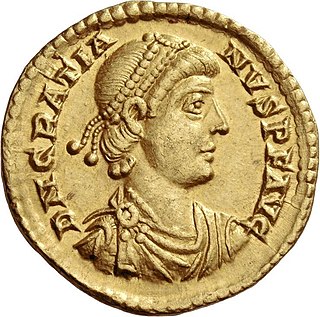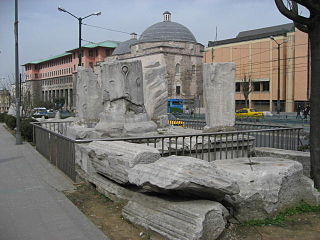
Theodosius I, also called Theodosius the Great, was Roman emperor from 379 to 395. During his reign, he faced and overcame a war against the Goths and two civil wars, and was key in establishing the creed of Nicaea as the orthodoxy for Christianity. Theodosius was also the last emperor to rule the entire Roman Empire before its administration was permanently split between two separate courts, one western, the other eastern.
The 380s decade ran from January 1, 380, to December 31, 389.

Gratian was emperor of the western part of the Roman Empire from 367 to 383. The eldest son of Valentinian I, Gratian accompanied his father on several campaigns along the Rhine and Danube frontiers and was raised to the rank of augustus in 367. Upon the death of Valentinian in 375, Gratian took over government of the west while his half-brother Valentinian II was also acclaimed emperor in Pannonia. Gratian governed the western provinces of the empire, while his uncle Valens was already the emperor over the east.

Valentinian II was a Roman emperor in the western part of the Roman empire between AD 375 and 392. He was at first junior co-ruler of his brother, was then sidelined by a usurper, and only after 375 sole ruler, albeit with limited de facto powers.

Flavius Victor was a Western Roman emperor from either 383/384 or 387 to August 388. He was the son of the Magister militum per Gallias Magnus Maximus, who later became an usurper of the Western Roman Empire, in opposition to Gratian. Maximus rose up in 383, and was recognized as the legitimate emperor in the west by Theodosius I. Victor was elevated to augustus of the Western Roman Empire in either 383/384 or mid-387, making him co-emperor with his father. Maximus invaded Italy, in 387, to depose Valentinian II, the brother and successor of the late Gratian. Because of Maximus' invasion, Theodosius invaded the Western Roman Empire in 388. Theodosius defeated Maximus in two battles in Pannonia, before crushing his army at Aquilea, and capturing Maximus. Maximus was executed on 28 August 388. His death was followed quickly by that of Victor, who was executed in Trier by the Frankish general Arbogast.

The Theodosian dynasty was a Roman imperial family that produced five Roman emperors during Late Antiquity, reigning over the Roman Empire from 379 to 457. The dynasty's patriarch was Theodosius the Elder, whose son Theodosius the Great was made Roman emperor in 379. Theodosius's two sons both became emperors, while his daughter married Constantius III, producing a daughter that became an empress and a son also became emperor. The dynasty of Theodosius married into, and reigned concurrently with, the ruling Valentinianic dynasty, and was succeeded by the Leonid dynasty with the accession of Leo the Great.

The Valentinianic or Valentinian dynasty was a ruling house of five generations of dynasts, including five Roman emperors during Late Antiquity, lasting nearly a hundred years from the mid fourth to the mid fifth century. They succeeded the Constantinian dynasty and reigned over the Roman Empire from 364 to 392 and from 425 to 455, with an interregnum (392–423), during which the Theodosian dynasty ruled and eventually succeeded them. The Theodosians, who intermarried into the Valentinian house, ruled concurrently in the east after 379.

The Arch of Drusus is an ancient arch in Rome, Italy, close to the First Mile of the Appian Way and next to the Porta San Sebastiano.

The Pons Cestius is an ancient Roman bridge connecting the right bank of the Tiber with the west of the Tiber Island in Rome, Italy. In Late Antiquity, the bridge was replaced and renamed the Pons Gratiani. It is also known as the Italian: Ponte San Bartolomeo, lit. 'Bridge of Saint Bartholomew'. No more than one third of the present stone bridge is of ancient material, as it was entirely rebuilt and extended in the 19th century, after numerous earlier restorations.
Galla was a Roman empress as the second wife of Theodosius I. She was the daughter of Valentinian I and his second wife Justina.

The Porta Esquilina was a gate in the Servian Wall, of which the Arch of Gallienus is extant today. Tradition dates it back to the 6th century BC, when the Servian Wall was said to have been built by the Roman king Servius Tullius. However modern scholarship and evidence from archaeology indicate a date in the fourth century BC. The archway of the gate was rededicated in 262 as the Arch of Gallienus.

In Ancient Rome, the Aqua Alsietina was the earlier of the two western Roman aqueducts, erected sometime around 2BC, during the reign of emperor Augustus. It was the only water supply for the Transtiberine region, on the right bank of the river Tiber.

The Forum of Theodosius was an area in Constantinople. It was originally built by Constantine I and named the Forum Tauri. In 393, however, it was renamed after Emperor Theodosius I, who rebuilt it after the model of Trajan's Forum in Rome, surrounded by civic buildings such as churches and baths and decorated with a triumphal column at its centre.

The Pons Neronianus or Bridge of Nero was an ancient bridge in Rome built during the reign of the emperors Caligula or Nero to connect the western part of the Campus Martius with the Ager Vaticanus, where the Imperial Family owned land along the Via Cornelia.

The Pons Probi was a bridge over the River Tiber in Ancient Rome, just south of Porta Trigemina.

The Arch of Dolabella and Silanus or Arch of Dolabella is an ancient Roman arch. It was built by senatorial decree in 10 AD by the consuls P. Cornelius Dolabella and C. Junius Silanus.

Arch of Nero is a now lost triumphal arch dedicated to the Roman emperor Nero that was located in Rome, Italy.
The Arch of Octavius was a triumphal arch on the Palatine Hill in Rome. It formed part of the sanctuary of Apollo adjoining Augustus's residence. It formed one of the entrances to the Area Apollinis, on the south side, turned towards the Murcia valley. It was built at the same time as the rest of the sanctuary, around 28 BC.
The Arch of Pietas was an ancient Roman triumphal arch to the north of the Pantheon on the Campus Martius in Rome.

The Regio IX Circus Flaminius is the ninth regio of imperial Rome, under Augustus's administrative reform. Regio IX took its name from the racecourse located in the southern end of the Campus Martius, close to Tiber Island.